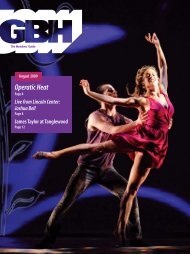Download program notes and libretto - WGBH
Download program notes and libretto - WGBH
Download program notes and libretto - WGBH
You also want an ePaper? Increase the reach of your titles
YUMPU automatically turns print PDFs into web optimized ePapers that Google loves.
II<br />
Twins<br />
The <strong>libretto</strong> of Niobe, Regina di Tebe, which was the second<br />
one written for Munich by Luigi Orl<strong>and</strong>i, is based on Greek<br />
mythology. Niobe <strong>and</strong> Anfione are the central characters of<br />
the plot.Amphion—“Anfione”in the Italian text—was rightly<br />
famous as a king of Thebes, but also as an incomparable<br />
musician, whose abilities built the walls of Thebes. Niobe was<br />
his wife, <strong>and</strong> together they had many children. So proud was<br />
Niobe of her offspring that they were called the Niobids, a<br />
notable exception to the rule that a Greek family is usually<br />
named after the Father. Niobe boasted of her superiority to<br />
Latona (Leto), the mother of Apollo <strong>and</strong> Diana, because the<br />
goddess had only two children, while she had given birth to<br />
many offspring. For her hubris, Apollo killed her sons, <strong>and</strong><br />
Diana, her daughters. Amphion, at the sight of his dead<br />
children, killed himself. The devastated Niobe turned to stone<br />
as she wept.The myth is clearly a moral warning to the human<br />
race to remain humble while enjoying earthly glory.<br />
Ovid, when he tells of the goddess’s revenge on Niobe in his<br />
Metamorphoses, <strong>notes</strong> that the children of Leto are twins:<br />
“The goddess was deeply angered, <strong>and</strong> on the top of Mount<br />
Cynthus she spoke to her twin children.‘I am your mother <strong>and</strong><br />
you are my pride, no one but Juno is a greater goddess, <strong>and</strong><br />
even now someone presumes to doubt my powers <strong>and</strong><br />
worship will be prevented at my altars, unless you help me,<br />
my children.’ ” In mythology, Diana was associated with the<br />
Moon, as her twin brother Apollo was associated with the Sun.<br />
This twinning, although based on a sexual difference,<br />
symbolizes their complementary places in the cosmic balance.<br />
According to Ovid, Latona was w<strong>and</strong>ering the earth with her<br />
newborn twins when she attempted to drink water from a<br />
pond. The peasants there refused to allow her to do so by<br />
stirring the mud at the bottom of the pond. Latona turned<br />
them into frogs for their lack of hospitality, forever doomed to<br />
swim in the murky waters of ponds <strong>and</strong> rivers. This scene is<br />
represented in the central fountain, the Bassin de Latone, in the<br />
gardens of Versailles.The choice of such a myth for the central<br />
spot of the gardens is an allusion to the difficult Regency for<br />
the mother of Louis XIV, to the“Fronde”—the uprising of the<br />
nobility against the queen regent—<strong>and</strong> to the ultimate victory<br />
of the French monarchy. The Parterre of Latona was designed<br />
by André Le Nôtre <strong>and</strong> built when the idea of making<br />
Versailles the center of power was still being developed; in<br />
1686, Jules Hardouin-Mansart adjusted the Latona Basin by<br />
elevating the central sculpture by the brothers Marcy with<br />
three levels of marble, placing it so it faced in the direction of<br />
the Gr<strong>and</strong> Canal where Apollo in full adulthood emerges<br />
triumphantly from the water on his chariot. This use of the<br />
space in the garden was itself an allegory of the coming of age<br />
of the Sun King.<br />
Niobe’s tale, as part of the story of Apollo, was also chosen to<br />
f e s t i va l o p e ra<br />
Latona <strong>and</strong> her children, Apollo <strong>and</strong> Diana, French etching of 1694 by<br />
Simon Thomassin (ca. 1652–1732) of the sculpture by Balthazar Marcy (1628–1674)<br />
<strong>and</strong> Gaspard Marcy (1624–1681), from Recueil des Figures, Groupes, Thermes,<br />
Fontaines, Vases, Statuës & autres Ornemens tels qu’ils se voyent á present dans<br />
le Château et parc de Versailles, gravé d’après les originaux.<br />
Par Simon Thomassin, Paris, 1694. Collection of Gilbert Blin.<br />
decorate the bedroom of the Sun King in his Parisian castle of<br />
Tuileries. The writer Félibien describes how the paintings of<br />
Mignard “from the story of Apollo befit the Sun, <strong>and</strong> besides,<br />
they are emblematic images of the beautiful actions of the king.<br />
[…] The story of Niobe shows the inevitable downfall of those<br />
who fail to keep the respect they owe to the sacred person of<br />
such a powerful monarch.” Le Brun used this same symbol in<br />
his first project for one end of the “Gr<strong>and</strong>e Galerie de<br />
Versailles,”known today as the Hall of Mirrors, which was to<br />
become an allegorical temple to the Sun King.<br />
The choice of Niobe as a subject for the entertainment of<br />
Maximilian Emanuel in Munich can also be read in the same<br />
allegorical way. In his dedication, printed at the beginning of<br />
137<br />
2 0 1 1 b o s t o n e a r l y m u s i c f e s t i v a l<br />
NIOBE, REGINA DI TEBE

















